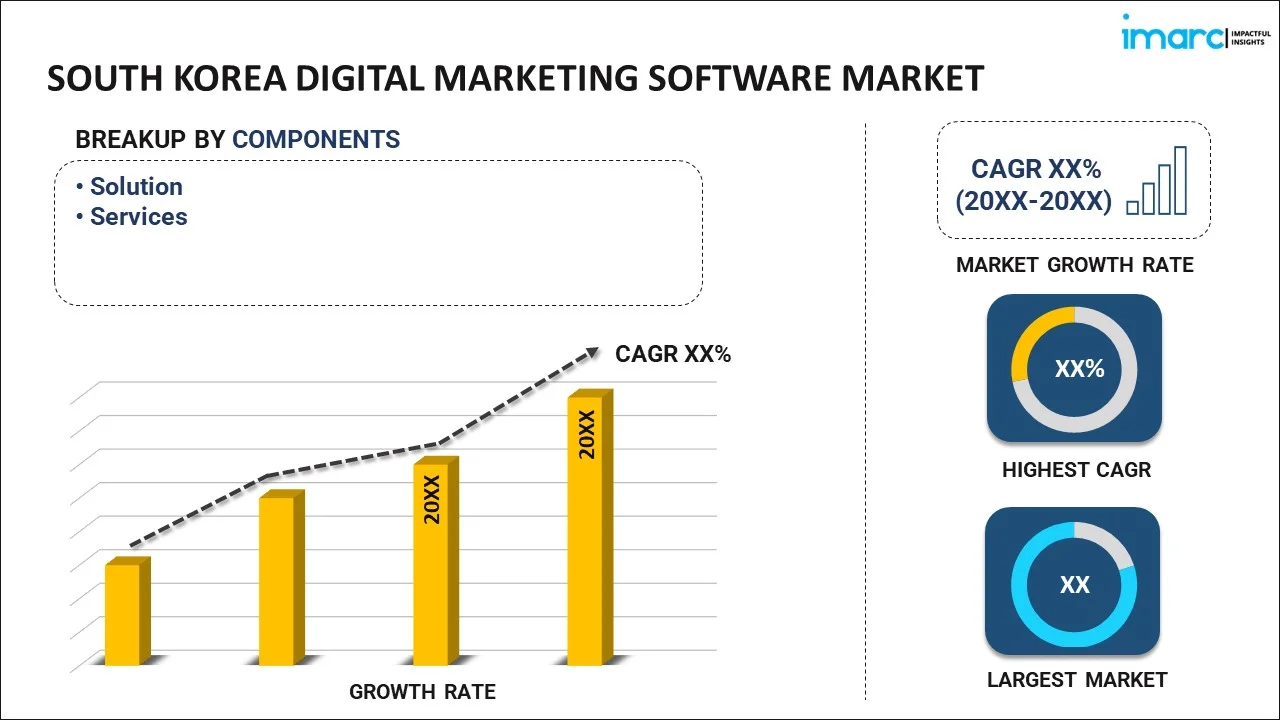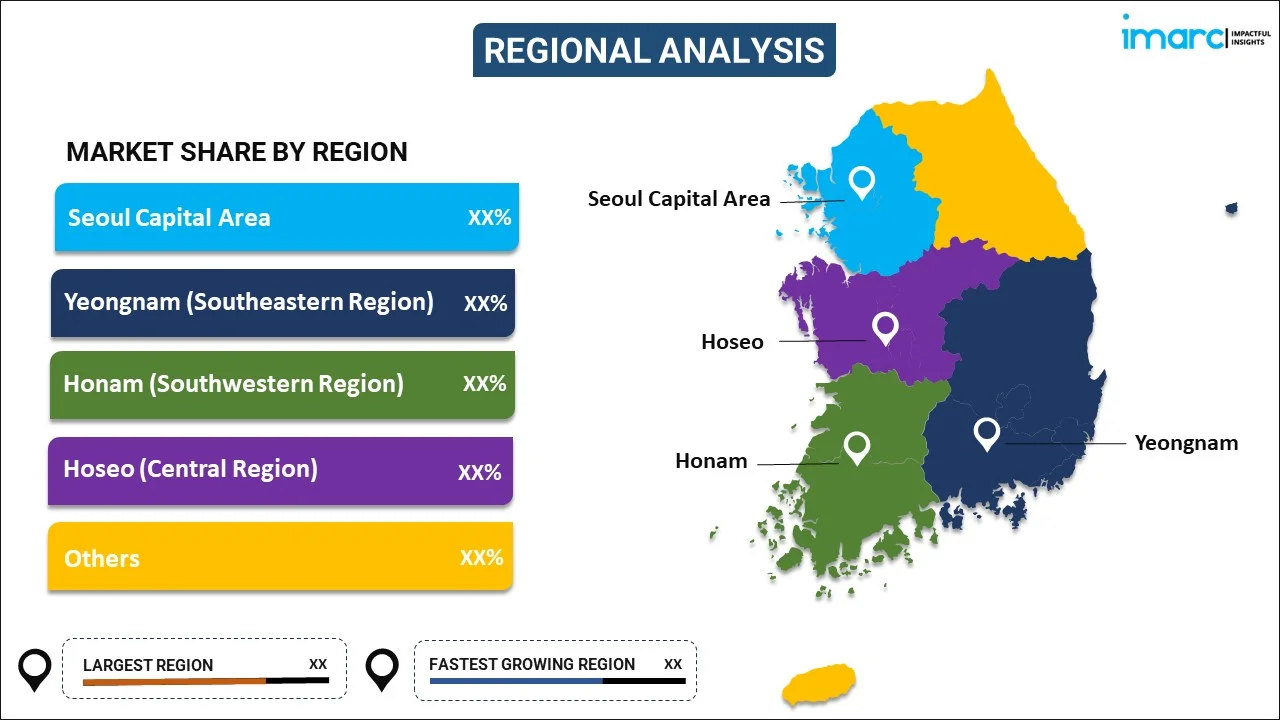
South Korea Digital Marketing Software Market Report by Component (Solution, Services), Deployment Type (On-premises, Cloud-based), Organization Size (Large Enterprises, Small and Medium-sized Enterprises (SMEs)), End Use (Media and Entertainment, Manufacturing, Retail, BFSI, Information Technology, Healthcare, and Others), and Region 2025-2033
Market Overview:
South Korea digital marketing software market size is projected to exhibit a growth rate (CAGR) of 18.43% during 2025-2033. The increasing digitalization of businesses and the rise of online platforms that have led companies to invest more in digital marketing software to enhance their online presence and reach a broader audience, is driving the market.
|
Report Attribute
|
Key Statistics
|
|---|---|
|
Base Year
|
2024 |
|
Forecast Years
|
2025-2033 |
|
Historical Years
|
2019-2024
|
| Market Growth Rate (2025-2033) | 18.43% |
Digital marketing software refers to a suite of tools designed to facilitate and enhance online marketing activities. These applications assist businesses in managing, analyzing, and optimizing various aspects of their digital campaigns. Key functionalities often include social media management, email marketing, search engine optimization (SEO), analytics, and content creation. By utilizing digital marketing software, organizations can streamline their marketing efforts, track performance metrics, target specific audiences, and automate repetitive tasks. This technology empowers businesses to make data-driven decisions, improve campaign efficiency, and ultimately enhance their online presence. With features tailored to diverse marketing needs, digital marketing software has become an indispensable asset for modern businesses seeking to navigate the dynamic landscape of online promotion.
South Korea Digital Marketing Software Market Trends:
The digital marketing software market in South Korea is flourishing, driven by a myriad of factors that collectively shape its trajectory. Firstly, the escalating reliance on online platforms has become a relentless force, propelling businesses to invest in comprehensive digital marketing solutions. As consumers increasingly migrate to digital spaces for their purchasing decisions, companies find themselves compelled to enhance their online presence and engagement strategies. This surge in demand is further exacerbated by the regional proliferation of e-commerce, with businesses vying for attention in the crowded digital landscape. Moreover, the advent of advanced technologies like artificial intelligence and machine learning has revolutionized digital marketing software, empowering companies to glean actionable insights from vast datasets. These cutting-edge capabilities not only facilitate targeted advertising but also enable personalized customer experiences, fostering brand loyalty. Additionally, the pervasive influence of social media continues to be a potent driver, with platforms like Facebook, Instagram, and Twitter serving as indispensable channels for customer engagement and brand promotion. Furthermore, the digital transformation across industries, which accentuates the need for agile and adaptable marketing solutions, is creating a positive outlook for the market. As businesses navigate the complexities of a post-pandemic landscape, digital marketing software emerges as a pivotal tool for resilience and growth. In essence, the confluence of these factors propels the digital marketing software market forward in South Korea, shaping a dynamic landscape poised for continuous evolution.
South Korea Digital Marketing Software Market Segmentation:
IMARC Group provides an analysis of the key trends in each segment of the market, along with forecasts at the country level for 2025-2033. Our report has categorized the market based on component, deployment type, organization size, and end use.
Component Insights:

- Solution
- Customer Relationship Management (CRM)
- Email Marketing
- Social Media
- Search Marketing
- Content Management
- Marketing Automation
- Campaign Management
- Others
- Services
- Professional Services
- Managed Services
The report has provided a detailed breakup and analysis of the market based on the component. This includes solution (customer relationship management (CRM), email marketing, social media, search marketing, content management, marketing automation, campaign management, and others) and services (professional services and managed services).
Deployment Type Insights:
- On-premises
- Cloud-based
The report has provided a detailed breakup and analysis of the market based on the deployment type. This includes on-premises and cloud-based.
Organization Size Insights:
- Large Enterprises
- Small and Medium Enterprises (SMEs)
A detailed breakup and analysis of the market based on the organization size have also been provided in the report. This includes large enterprises and small and medium enterprises (SMEs).
End Use Insights:
- Media and Entertainment
- Manufacturing
- Retail
- BFSI
- Information Technology
- Healthcare
- Others
The report has provided a detailed breakup and analysis of the market based on the end use. This includes media and entertainment, manufacturing, retail, BFSI, information technology, healthcare, and others.
Regional Insights:

- Seoul Capital Area
- Yeongnam (Southeastern Region)
- Honam (Southwestern Region)
- Hoseo (Central Region)
- Others
The report has also provided a comprehensive analysis of all the major regional markets, which include Seoul Capital Area, Yeongnam (Southeastern Region), Honam (Southwestern Region), Hoseo (Central Region), and Others.
Competitive Landscape:
The market research report has also provided a comprehensive analysis of the competitive landscape. Competitive analysis such as market structure, key player positioning, top winning strategies, competitive dashboard, and company evaluation quadrant has been covered in the report. Also, detailed profiles of all major companies have been provided.
South Korea Digital Marketing Software Market Report Coverage:
| Report Features | Details |
|---|---|
| Base Year of the Analysis | 2024 |
| Historical Period | 2019-2024 |
| Forecast Period | 2025-2033 |
| Units | Million USD |
| Scope of the Report | Exploration of Historical Trends and Market Outlook, Industry Catalysts and Challenges, Segment-Wise Historical and Future Market Assessment:
|
| Components Covered |
|
| Deployment Types Covered | On-premises, Cloud-based |
| Organization Sizes Covered | Large Enterprises, Small and Medium-sized Enterprises (SMEs) |
| End Uses Covered | Media and Entertainment, Manufacturing, Retail, BFSI, Information Technology, Healthcare, Others |
| Regions Covered | Seoul Capital Area, Yeongnam (Southeastern Region), Honam (Southwestern Region), Hoseo (Central Region), Others |
| Customization Scope | 10% Free Customization |
| Post-Sale Analyst Support | 10-12 Weeks |
| Delivery Format | PDF and Excel through Email (We can also provide the editable version of the report in PPT/Word format on special request) |
Key Questions Answered in This Report:
- How has the South Korea digital marketing software market performed so far and how will it perform in the coming years?
- What has been the impact of COVID-19 on the South Korea digital marketing software market?
- What is the breakup of the South Korea digital marketing software market on the basis of component?
- What is the breakup of the South Korea digital marketing software market on the basis of deployment type?
- What is the breakup of the South Korea digital marketing software market on the basis of organization size?
- What is the breakup of the South Korea digital marketing software market on the basis of end use?
- What are the various stages in the value chain of the South Korea digital marketing software market?
- What are the key driving factors and challenges in the South Korea digital marketing software?
- What is the structure of the South Korea digital marketing software market and who are the key players?
- What is the degree of competition in the South Korea digital marketing software market?
Key Benefits for Stakeholders:
- IMARC’s industry report offers a comprehensive quantitative analysis of various market segments, historical and current market trends, market forecasts, and dynamics of the South Korea digital marketing software market from 2019-2033.
- The research report provides the latest information on the market drivers, challenges, and opportunities in the South Korea digital marketing software market.
- Porter's five forces analysis assist stakeholders in assessing the impact of new entrants, competitive rivalry, supplier power, buyer power, and the threat of substitution. It helps stakeholders to analyze the level of competition within the South Korea digital marketing software industry and its attractiveness.
- Competitive landscape allows stakeholders to understand their competitive environment and provides an insight into the current positions of key players in the market.
Need more help?
- Speak to our experienced analysts for insights on the current market scenarios.
- Include additional segments and countries to customize the report as per your requirement.
- Gain an unparalleled competitive advantage in your domain by understanding how to utilize the report and positively impacting your operations and revenue.
- For further assistance, please connect with our analysts.
 Inquire Before Buying
Inquire Before Buying
 Speak to an Analyst
Speak to an Analyst
 Request Brochure
Request Brochure
 Request Customization
Request Customization




.webp)




.webp)












